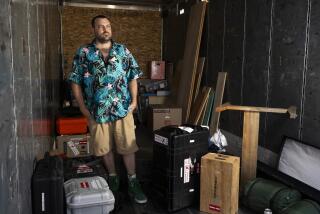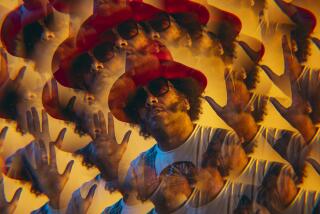ARTFULLY FRANTIC
“How long have you got, and how can I best guide you in?” So begins a phone call with Anthony Dod Mantle, the British-born cinematographer of “Slumdog Millionaire” on the line from his longtime home in Copenhagen. This blend of adventuresome attitude with a diligent attentiveness may explain why he has forged an ongoing creative relationship with “Slumdog” director Danny Boyle, with whom he has also worked on “Millions” and “28 Days Later,” as well as with such demanding directors as Lars von Trier and Thomas Vinterberg.
Shot on a mix of film and digital video, “Slumdog Millionaire” moves from shantytown slums to under-construction high-rises, capturing the tumult and change of Mumbai (formerly Bombay) as it follows the life of a young man desperate to fulfill his romantic destiny. The film’s style -- which finds a way to include a Bollywood-style dance number with hundreds of extras during the closing credits -- is an exciting reflection of a specific time and place, as well as the camaraderie and collaboration between Boyle and Mantle. (This interview took place before the recent terrorist attack on Mumbai.)
--
Now that you’ve worked with Danny Boyle a few times, how does he convey to you what he wants for a film like “Slumdog Millionaire,” especially with how to shoot in the slums?
He came with a few favorite adjectives like “energy” and “speed” and “running,” and he knows me well enough to know I’ll give it a go. He can be very strong and stubborn, but that’s also how he holds it all together. And we very quickly found out that even with ideas like energy, pace, speed, keep moving, do not try to control, at the same time I know he wants me to give him maximum quality. He’d never say that to me, he understands the difficulties, but I personally want to give him the best I can. For me, it’s like you go into a place with that kind of contrast and that kind of energy and that kind of attitude, it is in the light, it is in the shadows. If you come back with 70% of that because you have inferior tools, it’s like coming back with every third word dropping out of the actors’ dialogue. That’s very much my little crusade, so while Danny was casting in India I was back to Europe chasing around to different camera houses to try to configure these cameras to make it work.
--
Can you talk about the decision to shoot some of “Slumdog” on film and some of it on digital video? How did you decide what to shoot on which format?
Danny and I talked at first about shooting most of it on film, on celluloid, and some of it on this other format in the slums, because we had to find a way of just getting in there. What happens is, he falls in love with the cameras, he falls in love with the way I kind of move with them, and it was a new language we started to explore. Originally, we thought we were going to shoot about 70% on film and 30% on digital. We ended up shooting 60% on digital. And a small percentage was shot with a still camera on continuous burst, which intensifies the moment. Then I had to marry it all together.
--
There’s such a vibrancy to the film’s depiction of Mumbai, the city becomes something of a character in its own right.
Granted, we did stay in a Marriott and you had a clean bath and we got our washing done, but we were out in it generally six days a week, 16 hours a day. You can’t help but get sucked in. Danny did say once he’d never seen me quite how I was sometimes in Bombay because he’s so used to me getting on a controlled area in a quiet set and whipping it up to get the thing going. He saw me frustrated sometimes because we never got that. You are faced with an onslaught of energy all around up to the moment when the second slate goes and it’s clear and sometimes I’m seeing my scene in the frame for the first time. And it’s mentally exhausting. I had to adapt to a new way of thinking to keep my head in the story against that bombardment.
--
There’s that stunning shot of the rooftops in the slums where they seem to go on as far as the eye can see. Was that done with a helicopter?
No, there’s a little bit of helicopter stuff, which I delegated out to second unit. It’s in the film but not very much. I just climb up.
Everywhere I go, the first thing I do is look around on ground level, I look for holes in the ground and I look for hidden areas where we can plant small cameras.
And I always look up, I look for vantage points and I send production people like rabbits up and around, trying to get permission and we get an access point. It’s work, but it’s about trying to get more of Bombay in the film.
--
More to Read
Only good movies
Get the Indie Focus newsletter, Mark Olsen's weekly guide to the world of cinema.
You may occasionally receive promotional content from the Los Angeles Times.











